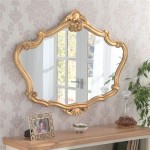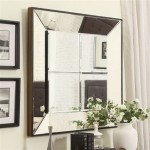Black Leaning Mirror: Aesthetics, Functionality, and Design Considerations
A black leaning mirror is a decorative and functional object that combines the reflective properties of a mirror with a specific design orientation. Unlike traditional wall-mounted mirrors, a leaning mirror rests against a wall, typically at a slight angle. The black frame, a defining characteristic, contributes to the mirror's aesthetic appeal, offering a contemporary or modern design element within various interior spaces.
The popularity of black leaning mirrors stems from their versatility and ability to enhance a room's perceived spaciousness and light. The full-length versions are particularly sought after for dressing areas and bedrooms, providing a practical tool for personal grooming while simultaneously serving as a statement piece. The black frame, regardless of material (wood, metal, or synthetic composites), offers a visual anchor, grounding the mirror and providing contrast to the surrounding decor.
The functionality of a black leaning mirror extends beyond visual reflection. It can be strategically placed to manipulate the flow of light within a room, brightening darker corners and creating the illusion of a larger area. This is especially beneficial in smaller apartments or rooms with limited natural light. Furthermore, the leaning aspect can offer a more relaxed and informal visual experience compared to perfectly vertical mirrors.
Understanding the Aesthetic Impact of Black Frames
The choice of a black frame significantly impacts the overall aesthetic of the mirror and its surrounding environment. Black, in design, is often associated with sophistication, elegance, and modernity. It provides a strong visual contrast against lighter-colored walls, effectively drawing the eye and making the mirror a focal point. This contrast is particularly effective in minimalist or Scandinavian-inspired interiors, where clean lines and simple color palettes are prevalent.
The specific shade of black can also influence the aesthetic impact. A matte black finish tends to absorb light, creating a more subtle and understated look. Conversely, a glossy black finish reflects light, adding a touch of glamour and formality. The texture of the frame, whether smooth or textured, further contributes to the overall visual impression.
Beyond color and texture, the width and style of the black frame play a crucial role. A thin, minimalist frame emphasizes the reflective surface of the mirror, while a wider, more ornate frame adds a decorative element that can complement other design features in the room. The frame's design can range from simple geometric shapes to more elaborate patterns, depending on the desired aesthetic.
Functional Applications and Placement Strategies
The functional utility of a black leaning mirror extends beyond its reflective properties. In bedrooms, it serves as a full-length dressing mirror, allowing for a comprehensive view of one's outfit. In living rooms or entryways, it can serve as a decorative accent, adding visual interest and brightening the space. The placement of the mirror is crucial to maximizing its functional benefits.
Strategic placement involves considering the existing light sources in the room. Placing the mirror opposite a window can amplify natural light, creating a brighter and more inviting atmosphere. In rooms with limited natural light, the mirror can be positioned to reflect artificial light sources, such as lamps or overhead fixtures. The angle at which the mirror leans against the wall can also be adjusted to optimize the reflection and minimize glare.
Consideration should also be given to the surrounding decor. The black frame of the mirror should complement the existing color scheme and design style of the room. For example, in a room with predominantly neutral colors, the black frame can provide a striking contrast. In a room with darker colors, the black frame can create a sense of depth and sophistication.
Safety is also a critical consideration when placing a leaning mirror. It is essential to ensure that the mirror is securely positioned against the wall to prevent it from falling over. This may involve using non-slip pads or brackets to secure the mirror in place. The mirror should also be placed in a location where it is unlikely to be bumped or knocked over, especially in homes with children or pets.
Material Considerations and Construction Quality
The choice of materials used in the construction of a black leaning mirror significantly impacts its durability, aesthetic appeal, and overall cost. The frame is typically constructed from wood, metal, or synthetic composites, each offering distinct advantages and disadvantages. The quality of the mirror glass itself is also a crucial factor in determining the clarity and longevity of the product.
Wooden frames offer a classic and versatile aesthetic, allowing for a wide range of design options. Hardwoods, such as oak or maple, are known for their durability and resistance to warping. Softwoods, such as pine, are more affordable but may be less resistant to damage. The wood can be painted or stained black to achieve the desired finish, and various decorative details can be added to enhance the frame's aesthetic appeal.
Metal frames offer a more contemporary and industrial aesthetic. Steel and aluminum are commonly used materials, known for their strength and durability. Metal frames can be powder-coated or painted black to achieve a smooth and uniform finish. The clean lines and minimalist design of metal frames make them a popular choice for modern interiors.
Synthetic composite frames, such as MDF (Medium-Density Fiberboard) or PVC (Polyvinyl Chloride), offer a more affordable and lightweight alternative to wood or metal. These materials are resistant to moisture and warping, making them suitable for use in bathrooms or other humid environments. Synthetic composite frames can be molded into various shapes and painted or finished to resemble wood or metal.
The quality of the mirror glass is equally important. High-quality mirror glass is free from distortions and imperfections, providing a clear and accurate reflection. The thickness of the glass also affects its durability and resistance to breakage. Thicker glass is less likely to shatter if accidentally bumped or knocked over.
The construction quality of the mirror is another critical factor. The frame should be securely attached to the mirror glass, and all joints should be properly sealed to prevent moisture from seeping in. The back of the mirror should be protected with a backing material to prevent damage and ensure the mirror's longevity.
When selecting a black leaning mirror, consideration should be given to the materials used in its construction and the overall quality of workmanship. A well-made mirror will not only enhance the aesthetic appeal of the room but will also provide years of reliable service.

Large Black Thin Framed Leaner Mirror 80cm X 180cm Flora Furniture

Delaney Black Leaning Mirror Cort Furniture

Leaner Mirror Black Abbey Shabby Chic Floor Standing Mirrors

Decorative Black Leaning Mirror

Flynn Curve Leaning Mirror Black A C Home

Jupe 180x90 Black Leaning Mirror Basics Home

Black Framed Leaner Mirror 33x79 In Kirklands Home

Xramfy 71 In H X 31 W Classic Rectangular Black Framed Aluminum Alloy Full Length Leaning Mirror Omrtsc3171 The Home Depot

How To Secure A Leaning Mirror The Wall Diy Playbook

Beautypeak 71 X31 Full Length Mirror Rectangle Floor Mirrors For Standing Leaning Or Hanging Black Com








